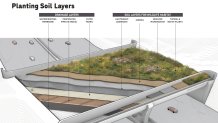
This rendering depicts a wildlife crossing over the 101 Freeway near Los Angeles.
What to Know
- The Wallis Annenberg Wildlife Crossing, a bridge created for animals, is under construction in Agoura Hills
- The Highway 101-spanning feature has been years in the making; now "the first layers of soil" will be placed on the bridge as March 2025 concludes and April begins
- Some "6,000 cubic yards of soil" will be required to cover the colossal crossing
- Construction on the bridge began Earth Day 2022
- The span is scheduled to be completed in 2026
- Tours of the multi-year project are available on select dates; get information on signing up at this site
The Wallis Annenberg Wildlife Crossing, a colossal animal bridge spanning the 101 Freeway in Agoura Hills, has experienced several important "firsts" even as its official opening remains several months away.
There was the idea that first simmered in the minds and hearts of nature champions around Southern California and beyond years ago, the breaking of the ground on Earth Day 2022, the "early adopter" seen flying over the under-construction pass in 2024, and the first public tour of the site.
Now a new chapter is beginning for the Wildlife Crossing, and it is truly the project's earthiest development yet.
Get top local stories in Southern California delivered to you every morning. Sign up for NBC LA's News Headlines newsletter.
Crews will begin placing soil on the bridge, all to ready it for the all-important vegetation and natural features, an environment that will provide traveling animals safe, wild, and undisturbed passage as they trot over high over the 101 freeway.

Some 6,000 cubic yards of soil will be placed on the enormous span, the earthy base for what will soon "... become a nearly 1-acre native wildlife habitat across ten lanes of the U.S. Highway 101 freeway in the City of Agoura Hills."
The Scene
Want to find new things to do in Los Angeles? The Scene's lifestyle stories have you covered. Here's your go-to source on where the fun is across SoCal and for the weekend.
Soil scientists have been engaged in the extensive preparations for the crossing's next chapter, along with biologists, engineers, and, indeed, mycologists, the scientists who are working to ensure that "beneficial fungi" play a role in these crucial layers.
Coastal sage scrub plants, the "species native to the Santa Monica Mountains," will be added to the habitat down the road. In fact, the bridge's well-considered landscape will be "comprised exclusively" of these regional specimens.

"Soil is the stuff of life and the success of a wildlife crossing relies on a healthy landscape layer and that starts with soil!" said Nina-Marie E. Lister, Professor and Director of the Ecological Design Lab at the Toronto Metropolitan University.
"Unlike the engineered bridges that are so familiar to people living in urban cities all over the world, the Wallis Annenberg Wildlife Crossing will not only have a technically designed surface that is supported by science — but also a surface that is very much alive and that will support future plant communities in the Santa Monica mountains and the wildlife that need and depend on a reconnected ecosystem."
While the bridge will help critters as they roam the lands visited by their ancestors for eons, it will also aid in the safety of the motorists traveling along the highway, too.
Eager for a closer look at the site? Sign up for an informative tour at this page.



